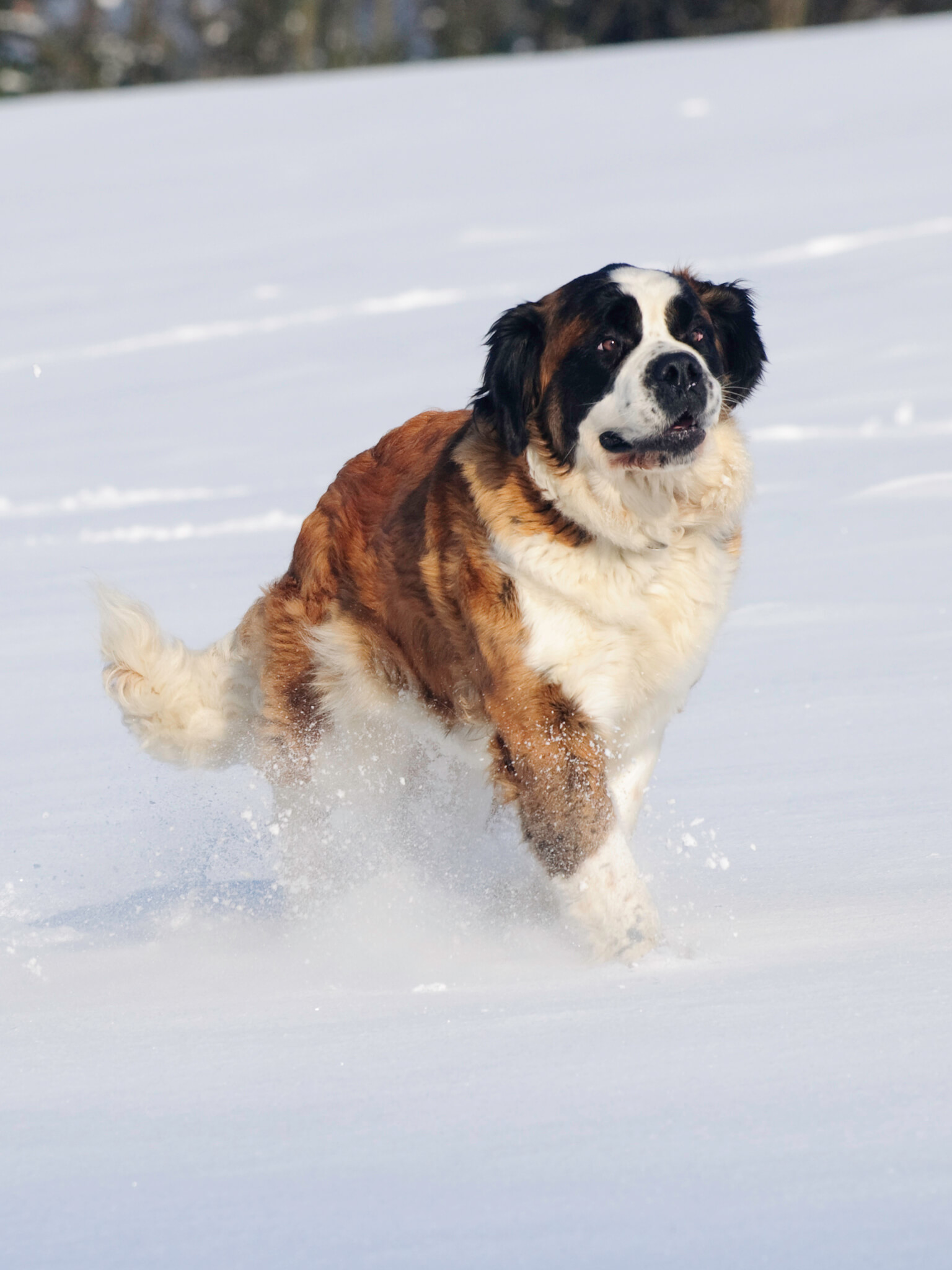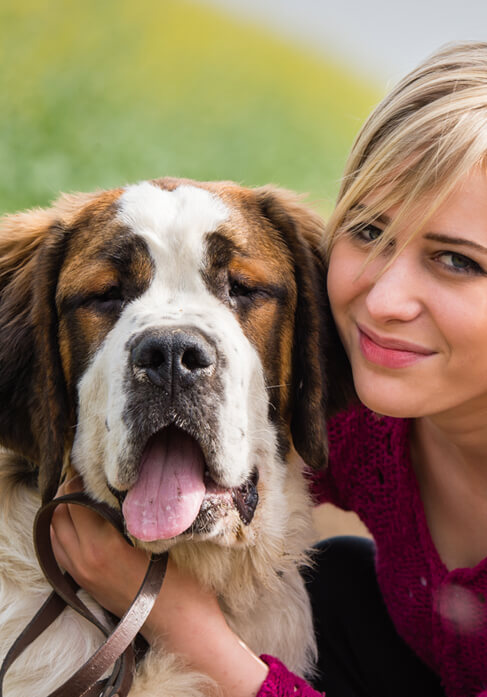Privacy Policy: Your email address is 100% safe.
We don't spam and hate it as much as you do :-) You can also unsubscribe from our mailing list at any time.

Sign Up
Saint Bernard: Training, Personality, Health, Grooming (St Bernard)

Country of Origin, History of Saint Bernards
The Saint Bernard is a descendent of the Tibetan mastiffs taken to the Alps by the Romans about 1000 AD. The Swiss monks of St. Bernard de Menthon crossed the mastiffs with Great Danes and Great Pyrenees. By the middle of the 1600s its use as a rescue dog was well established.
More than 2,000 people have been saved by St. Bernards. The dogs work in teams to search out and find lost or injured travelers and lick them to get their circulation going and then one dog lies next to them to give them warmth. Another dog goes back to get a human rescue team and leads them back to the traveler and other dog(s). St. Bernard’s sense of smell is so great that he can find a person even under many feet of snow.
The short-haired St. Bernard is more often used for search and rescue as the long-haired version has a problem with his long hair collecting icicles.
Saint Bernard Tools
Breed Selector Tool - is the Saint Bernard the right breed for you?
Is the Saint Bernard the right breed for you and your family?
Find out by using our Free Dog Breed Selector Tool
Check Your Saint Bernard's Learning Style
Are you aware dogs also have a learning style that can greatly affect their ability to housetrain as well as be trained correctly. Evaluate your Saint Bernard's learning style and personality using our free Learning Style tool so that you are better able to provide him with the proper Saint Bernard training methods.
Is your Saint Bernard dominating over you?
Does your Saint Bernard bark unnecessarily? Does your Saint Bernard come to you when you call? Download a FREE Report on Dog Dominance for you and your Saint Bernard and learn how to control your dog.
Do you make these mistakes with your Saint Bernard?
Are you inadvertently snow-balling bad behavior in your Saint Bernard? Evaluate your Dog Training Style from our Free Tool and learn how best to deal with your dog.
Saint Bernard Calorie Calculator
Do you know how many calories your Saint Bernard needs every day and how many cups of food you should be giving it every day? Click here to use our Saint Bernard Calorie Calculator.

A General Appearance of the Dog
The St. Bernard is a very massive, muscular dog with an imposingly large head and equally large paws. His toes are highly arched so that he can walk well in snow and ice. His weight should be in proportion to his size. The St. Bernard’s muzzle is short, his ears are rather high set and hang down. The nose is very wide causing the dark brown eyes to be widely set. His look is of intelligence, wisdom, and the ability to deal with dangerous situations – “Just relax; I’ve got it under control.”
All four of the Saint Bernard’s legs are well-muscled. His chest is moderately deep but does not reach below his elbows. Add to that a broad back and broad, muscular shoulders and you get a powerhouse of a dog. Even his tail is broad and powerful as it helps to propel and balance him when he is climbing.
Coat Color
The base coat color is white, but it is well marked in tan, red, mahogany, brindle, and black. The face and ears usually have shadings of black.
Coat Type
St. Bernards have two different coat types: rough (Long-haired) and smooth (Short-haired). Both coats are dense and warm. The Shorth-haired or Smooth-coated St. Bernard’s coat lies smoothly over his body. The thighs are slightly bushy and the tail appears bushy. The Rough or Long-haired coat is longer than the smooth coat and slightly wavy. With the rough coat there is feathering on the legs and tail.
Height
Male: at least 27.5 inches
Female: at least 25.5 inches
The taller the dog, the more he is valued as long as the weight is in proportion to the height.
Weight
110 – 200 lbs



Free Saint Bernard Training Secrets
Free Course on Saint Bernard Training & Obedience
Stop All Bad Behavior, Excessive Barking and Biting
Saint Bernard Personality Traits

Temperament of the Dog
The Saint Bernard is extremely gentle, caring, and sensitive to people's needs and desires. Desirous to please, he is loyal and obedient.
The St. Bernard makes a great family companion. He is very tolerant of children. HIs instincts provide a natural watchdog warning of anything or anyone approaching, but he is not aggressive. However, his size would deter most would-be intruders. He is a “couch potato” but have plenty of energy and stamina when motivated.
Be sure to provide plenty of socialization for the St. Bernard as a puppy. Make sure he meets all types of people and is exposed to a wide variety of experiences and noises.
The St. Bernard is very intelligent and learns easily and quickly. Because they get so large, they should start obedience training as young as possible. Remember that an unruly 175-pound dog on a leash can present a number of problems, especially in public. Make sure, as the owner, you control the dog and the dog does not control you from the beginning.
Saint Bernards are sure-footed in snow and ice. Their sense of smell is such that they can find people buried under many feet of snow. They also have a sixth sense about impending danger, especially storms and avalanches.
Because St. Bernards have jowls, they drool after they eat or drink.
Better suited to an indoor or outdoor lifestyle?
Saint Bernards love the outdoors but they need time inside with their family. Because of their thick coats, they prefer cool climates. They cannot handle warm rooms or cars or hot weather. Air conditioning is a must if they are in a climate with warm summers.
Are they suited to homes with kids?
St. Bernards love children. Their gentleness and sensitivity to people make them a wonderful family pet. They can be boisterous when young and, because of their size, can knock youngsters down, but they would never hurt a family member or friend.
Saint Bernard Activity Level
How Active is the Breed?
The St. Bernard is rather boisterous when young but settles down by age 2. He continues to have energy and stamina throughout his life, but is calmer indoors than outdoors as an adult. He enjoys both mental and physical stimulation.
How Much Exercise Does the Dog Need at every stage of its Life?
Until he is two years old, a St. Bernard needs several short walks or short play times a day. His bones and muscles are still forming. After two years of age, he can survive on one to two long walks a day and a play time in a dog park or fenced yard a couple of times a week. Therefore, he can live in an apartment or a house with a small, fenced yard.
Grooming
Both types of coats are easy to care for – brush with firm bristle brush twice a week. Do not bathe unless absolutely necessary as it strips the oil from the coat. They shed heavily twice a year.
Pay attention to their eyes as they get watery and goopy and need frequent cleaning and may need drops to keep them free of allergens and irritants.


Free Saint Bernard Training Secrets
Free Course on Saint Bernard Training & Obedience
Stop All Bad Behavior, Excessive Barking and Biting
Health and Care
Genetic Problems
Generally, Saint Bernards are a healthy breed. As a large dog, they have a tendency toward bloat and torsion of the stomach so should be fed 2-3 small meals a day. Also, as a large dog, they can have hip and elbow dysplasia. Other problems include “wobbler” syndrome, heart problems, skin problems, and extropion.
Life Span: As one of the largest dogs, St. Bernards have a fairly short life span of 8 – 10 years.
National Breed Clubs
National Breed Clubs
British – English St. Bernard
Club – www.englishsaintbernardclub.org
US – Saint Bernard Club of America –
www.saintbernardclub.org
Other Recognition: CKC, FCI, AKC, UKC, KCGB, CKC, ANKC, NKC, NZKC, APRI, ACR
Rescue Link: www.saintbernardclub.org/rescue.htm
Group:Working Group.
AKC Ranking: 48
Also Known As: St. Bernard, St. Bernhardschund, Alpine Mastiff, Bernhardiner
Train Your Saint Bernard To Listen To You
Get Instant Access to Your Training Now - For Free
Sign up for our Free Saint Bernard Mini Course to have a housebroken, obedient dog that happily comes to you every time you call.
You'll learn new commands to obedience-train your dog as well as how to housebreak your dog in 6 days or less.
You'll also learn how to eliminate bad habits like barking, nipping or biting, jumping, or pulling on the leash.Here's just s small fraction of what else you'll learn in the course:
How to lead and think like a pack dog - the new psychology.
3 dangerous mistakes that most St. Bernard owners make when they are trying to potty train their dogs.
The 2 main reasons why your dog barks excessively and how to control its excessive barking.
How to obedience train your Saint Bernard to permanently end behavioral problems like Jumping, Aggression, Pulling on Leash.
A surprisingly easy way to teach your dog cool new tricks.
How to improve your dog's lifespan and keep it from getting overly heavy with a healthy and nutritious diet.
Getting Pro help fast - how to get access to our expert trainers when you need them most.
One hidden psychological trigger that all Saint Bernards have... that practically allows you to "analyze" and "control" your dog's every action.
Priority access to the free online seminars conducted by our training experts.
Whereas other dog training related web sites and books offer generic information for dogs in general, ours is the ONLY web site that offers St. Bernard information specifically, from a renowned panel of experts - because as you probably know, St. Bernards have their own special training requirements that other dogs don't have.
Our Dog Experts
The Saint Bernard training information you will read here was developed by a panel of renowned dog training experts whose combined wisdom represents nearly 100 years of specialist experience training dogs.
Here are a few of our experts:




